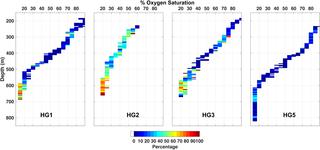Our official English website, www.x-mol.net, welcomes your
feedback! (Note: you will need to create a separate account there.)
Diel patterns in swimming behavior of a vertically migrating deepwater shark, the bluntnose sixgill (Hexanchus griseus).
PLOS ONE ( IF 2.9 ) Pub Date : 2020-01-24 , DOI: 10.1371/journal.pone.0228253 Daniel M Coffey 1 , Mark A Royer 1 , Carl G Meyer 1 , Kim N Holland 1
PLOS ONE ( IF 2.9 ) Pub Date : 2020-01-24 , DOI: 10.1371/journal.pone.0228253 Daniel M Coffey 1 , Mark A Royer 1 , Carl G Meyer 1 , Kim N Holland 1
Affiliation

|
Diel vertical migration is a widespread behavioral phenomenon where organisms migrate through the water column and may modify behavior relative to changing environmental conditions based on physiological tolerances. Here, we combined a novel suite of biologging technologies to examine the thermal physiology (intramuscular temperature), fine-scale swimming behavior and activity (overall dynamic body acceleration as a proxy for energy expenditure) of bluntnose sixgill sharks (Hexanchus griseus) in response to environmental changes (depth, water temperature, dissolved oxygen) experienced during diel vertical migrations. In the subtropical waters off Hawai'i, sixgill sharks undertook pronounced diel vertical migrations and spent considerable amounts of time in cold (5-7°C), low oxygen conditions (10-25% saturation) during their deeper daytime distribution. Further, sixgill sharks spent the majority of their deeper daytime distribution with intramuscular temperatures warmer than ambient water temperatures, thereby providing them with a significant thermal advantage over non-vertically migrating and smaller-sized prey. Sixgill sharks exhibited relatively high rates of activity during both shallow (night) and deep (day) phases and contrary to our predictions, did not reduce activity levels during their deeper daytime distribution while experiencing low temperature and dissolved oxygen levels. This demonstrates an ability to tolerate the low oxygen conditions occurring within the local oxygen minimum zone. The novel combination of biologging technologies used here enabled innovative in situ deep-sea natural experiments and provided significant insight into the behavioral and physiological ecology of an ecologically important deepwater species.
中文翻译:

垂直迁移的深水鲨(钝角长尾six)的游泳行为中的迪尔模式。
Diel垂直迁移是一种广泛的行为现象,在这种行为中,生物通过水柱迁移,并可能基于生理耐受性而改变与环境条件有关的行为。在这里,我们结合了一套新颖的生物测井技术,以检查响应于以下情况的钝嘴六腮鲨(Hexanchus griseus)的热生理学(肌肉内温度),精细尺度的游泳行为和活动(整体动态身体加速度作为能量消耗的代理)。 diel垂直迁移过程中遇到的环境变化(深度,水温,溶解氧)。在夏威夷外的亚热带水域中,六g鲨进行了明显的垂直el角迁移,并在寒冷(5-7°C)下花费了大量时间,日间分布较深时氧气含量低(饱和度为10-25%)。此外,六g鲨的大部分白天分布较深,其肌肉内温度要比环境水温高,因此,它们比非垂直迁移和小型猎物具有明显的热优势。Sixgill鲨鱼在浅(夜间)和深(白天)阶段均表现出相对较高的活动率,与我们的预测相反,它们在较深的白天分布中并未降低活动水平,同时遇到低温和溶解氧水平。这证明了有能力忍受在局部最低氧区域内发生的低氧条件。
更新日期:2020-01-26
中文翻译:

垂直迁移的深水鲨(钝角长尾six)的游泳行为中的迪尔模式。
Diel垂直迁移是一种广泛的行为现象,在这种行为中,生物通过水柱迁移,并可能基于生理耐受性而改变与环境条件有关的行为。在这里,我们结合了一套新颖的生物测井技术,以检查响应于以下情况的钝嘴六腮鲨(Hexanchus griseus)的热生理学(肌肉内温度),精细尺度的游泳行为和活动(整体动态身体加速度作为能量消耗的代理)。 diel垂直迁移过程中遇到的环境变化(深度,水温,溶解氧)。在夏威夷外的亚热带水域中,六g鲨进行了明显的垂直el角迁移,并在寒冷(5-7°C)下花费了大量时间,日间分布较深时氧气含量低(饱和度为10-25%)。此外,六g鲨的大部分白天分布较深,其肌肉内温度要比环境水温高,因此,它们比非垂直迁移和小型猎物具有明显的热优势。Sixgill鲨鱼在浅(夜间)和深(白天)阶段均表现出相对较高的活动率,与我们的预测相反,它们在较深的白天分布中并未降低活动水平,同时遇到低温和溶解氧水平。这证明了有能力忍受在局部最低氧区域内发生的低氧条件。











































 京公网安备 11010802027423号
京公网安备 11010802027423号